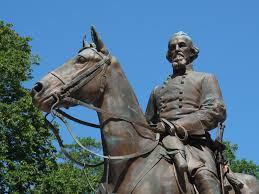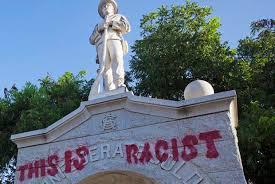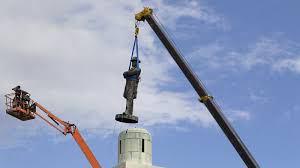 Mitch Landrieu was mayor of New Orleans, 2010-18. In 2015 he started the process of removing Confederate monuments. Landrieu expected opposition, but its ferocity surprised him. Such was the violence and intimidation that it was a big problem even getting contractors to do the work. Statue removal became something of a military operation.
Mitch Landrieu was mayor of New Orleans, 2010-18. In 2015 he started the process of removing Confederate monuments. Landrieu expected opposition, but its ferocity surprised him. Such was the violence and intimidation that it was a big problem even getting contractors to do the work. Statue removal became something of a military operation.
We saw Landrieu interviewed on The Daily Show and were very impressed. So my wife bought me his book, In the Shadow of Statues: A White Southerner Confronts History.
The book impressed me even more, for its eloquence in expressing fundamental human good will, honesty, and decency; the values that made America great. And I wept anew at the contrast between that virtuous Americanism and Trumpist loathesomeness.

One thing Landrieu talks about is the schools. Even before Katrina they were a disaster area. The storm literally destroyed most of New Orleans’ public schools. But instead of just rebuilding them, the city took a different path, going whole-hog with charter schools. The liberal rap is that they “siphon” resources from public education, cream the best students, and educate them less well. This ignores that our most disadvantaged kids are the worst served by their public schools, and they do better in charters. Landrieu relates that switching his city to mainly a charter school model has produced way better results — especially for black kids.

“Very fine people on both sides”
Landrieu sees the subject of race as central to his whole life story. I used to optimistically believe the bad old days were behind us, with racism confined to dark peripheral corners of American society. That even the South had culturally moved on. We’d elected a black president, after all. But I’ve come to realize those dark corners are larger than I’d thought. (Indeed, Trump has brought racism out of the corners.)

After the Civil War, Southern whites created “the Cult of the Lost Cause” — romanticizing it as having been a battle for states’ rights and, mainly, the noble defense of a genteel culture, contrasted against a Northern one dark with factory smoke and industrialist greed.
Truth: The war was about slavery. No slavery, no war. “States’ rights?” It was the right to enslave human beings. The supposedly refined culture being defended had its foundation in the kidnapping, brutalization, torture, and rape of human beings. So much for moral superiority. This was not some noble cause, but among the foulest in history.
Of course, southern whites didn’t see themselves as brutalizing human beings. To anesthetize their consciences they convinced themselves blacks were inferior creatures, made by God to be slaves. Thus the salience of white supremacy thinking. (Today’s white supremacists are self-refuting; their belief, contrary to biological fact, proves it’s they who are the less evolved creatures.)
After the war that freed the slaves, southern whites strove to undo that result to the greatest extent possible through a campaign of violence and terror to beat down black people and eviscerate their human rights.

And there were never any memorializing slavery’s victims.
Landrieu’s tale did, again, impress upon me the depth of white racism still persisting. As he chronicles, unreconstructed whites responded regarding the monuments just as they had to emancipation, and the civil rights era, with terroristic violence. A noble cause honoring history? Yeccch.
While the former Confederate states have big black populations, they are minorities, and voting is largely along racial lines. Republicans are the white party. Not all, but a majority of southern whites who vote Republican are voting to express disapproval and hostility toward black citizens. (There’s not a single white Democratic congressman left from the south.)
America has never been a perfect country. But its greatness — exemplified by Mitch Landrieu’s story — has always been its striving toward perfection, through the efforts of people like him, with nobility of spirit. And even despite what I’ve written here, we had indeed been on an upward path, toward a more perfect union.

But alas right now we’re on a radical detour from that path of human progress. A sharp lurch downwards.
Landrieu is being touted for president. He’d be the perfect candidate to beat Vile Creep. Would the Democrats have enough sense to nominate him? Would America have enough moral sense to elect him?
Advertisements